
* Although the F-104 did not have a major career with the USAF, it was acquired enthusiastically by foreign air forces, with Lockheed licensing the type for manufacture in a number of nations. This chapter discusses the definitive "F-104G" Starfighter variant and its use in foreign service, covering countries that built the Starfighter. Nations that acquired but did not build the Starfighter are discussed in the next chapter.
* The USAF purchased only a relatively modest number of F-104s, and so Lockheed needed to find a foreign buyer to keep the program going. In the late 1950s, a number of foreign governments were casting about for a Mach 2 fighter, for the most part to replace North American F-86 Sabre fighters and interceptors, as well as Republic F-84 Thunderjet / Thunderstreak strike fighters and RF-84 Thunderflash reconnaissance aircraft.
A number of US manufacturers were offering proposals to meet the need. Grumman had a flying prototype of the "F11F-1F Super Tiger", a J79 powered version of the company's J65 powered F11F-1 Tiger shipboard fighter; North American was promoting the "F-100J", an improved version of the company's F-100 Super Sabre; and Northrop was promoting a lightweight fighter, the "N-156". Since the F11F-1F was flying while the F-100J and N-156 were both paper proposals, the Super Tiger was the F-104's only serious opponent in the competition.
The West German Luftwaffe was the main prospective customer, with a requirement for a multi-role aircraft that could be used as an interceptor / air superiority fighter, fighter-bomber, and reconnaissance aircraft. Luftwaffe pilots evaluated both the Starfighter and Super Tiger, and on 6 November 1958 the West German government announced the Starfighter had won the competition, leading to award of the first procurement contract on 18 March 1959. Some authors wonder how the Germans were persuaded to obtain an aircraft that was already known to be accident-prone, but others reply that it was because the flight evaluations showed the Starfighter was the best aircraft. It should be noted that the flight evaluations were no doubt conducted by very experienced pilots who were capable of handling the hot F-104 without great difficulty.
The Super Tiger wouldn't go into production, and the F-100J would never be built; the N-156 would emerge as the Northrop F-5A, and prove a great success in the export market.
* The Luftwaffe variant was designated the "F-104G", with "G" for "Germany" of course. The F-104G was essentially an enhanced F-104C, featuring:
The centerline stores station of the F-104G could be fitted with an improved "catamaran" rack, less draggy than that used on the F-104C, to carry two Sidewinder AAMs. This fit is rarely shown in pictures of the F-104G.
___________________________________________________________________
LOCKHEED F-104G STARFIGHTER:
___________________________________________________________________
wingspan:
6.63 meters (21 feet 9 inches)
wing area:
18.22 sq_meters (196.1 sq_feet)
length:
16.66 meters (54 feet 8 inches)
height:
4.09 meters (13 feet 5 inches)
empty weight:
6,350 kilograms (13,995 pounds)
MTO weight:
13,170 kilograms (29,040 pounds)
max speed at altitude:
1,845 KPH (1,145 MPH / 995 KT)
service ceiling:
17,675 meters (58,000 feet)
range, no tanks:
1,740 kilometers (1,080 MI / 940 NMI)
___________________________________________________________________
Several nations also obtained the single-seat "RF-104G" reconnaissance variant, which carried a "trimetrogon" camera arrangement in a fairing behind the tailwheel -- featuring one camera shooting straight down, along with and a camera shooting off to each side, to give a wide-angle of the ground below the flight track. A two-seat "TF-104G" was designed as well. It was much like the F-104D, but had the various enhancements of the F-104G; while the Vulcan cannon was of course deleted, the TF-104G was otherwise fully combat-capable.
* The West German buy was a strong endorsement for the Starfighter, and several other nations soon signed up to buy the F-104G or some variation on it:
The CF-104 and F-104J are discussed in more detail below. Lockheed had won what would be called the "Deal of the Century". Although the various governments would buy most of their Starfighters with their own funding, they would also in many cases obtain additional aircraft through US Military Assistance Program (MAP) funding.
The first F-104G / CF-104 prototype, a modified F-104A, performed its initial flight on 5 October 1960. European license production was performed by a wide network of European firms, with four different production groups led by Messerschmitt in Germany, Fokker in the Netherlands, the Societe Anonyme de Constructions Aeronautiques (SABCA) in Belgium, and Fiat of Italy. Lockheed also performed some production of the F-104G on its own for foreign sales, and Canadair built a number of F-104Gs for export.
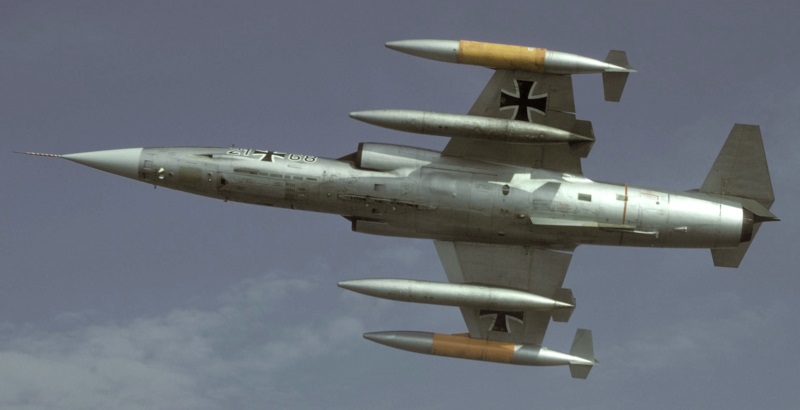
Final construction tallies of the F-104G and RF-104G from the various production groups were as follows:
That gave a total of 1,103 F-104G and 195 RF-104G, or 1,298 in all. Lockheed was the primary manufacturer for the TF-104G operational trainers, which were distributed to the various F-104G users. Lockheed did all production of TF-104Gs up to 1964; after that, the company moved to co-production arrangements after that time, with Lockheed performing assembly but obtaining major subassemblies from foreign partners. Total production of the TF-104G amounted to 220 aircraft.
There was actually quite a bit of subcontracting going on between the various companies building the Starfighter, for example with Canadair providing subassemblies to other manufacturers, including Lockheed. Lockheed and Canadair F-104G / CF-104 production often went to a number of nations not involved in license production under MAP, including Denmark, Greece, Norway, Spain, Taiwan, and Turkey.
The Starfighter would be the backbone of NATO and many other fighter forces in the 1960s and 1970s. In the 1980s, it would be generally replaced by other types, most prominently the General Dynamics (later Lockheed Martin) F-16, which scored another "Deal of the Century" comparable to that won by the F-104.
BACK_TO_TOP* The Germans were the first foreign buyer of the Starfighter and, at least in terms of numbers obtained, the most enthusiastic user of the type. They received an initial batch of 30 "F-104F" trainers from Lockheed in late 1959. These were more or less F-104Ds, fitted with the uprated J79-GE-11A engine plus simplified avionics, and were to be used in principle to get the Luftwaffe up to speed on the Starfighter. They were retired in 1972.
The Germans then obtained 605 F-104Gs, 145 RF-104Gs, and 137 TF-104Gs, replacing F-86s and F-84s / RF-84s. The order was so huge that it soaked up all of the production of the Messerschmitt-led group, and took production from the other F-104G manufacturing groups as well. German F-104Gs featured the F15A-41B version of the NASARR radar, with navigation, bombing, and air-to-air modes. Navigation and bombing modes featured ground-mapping, terrain following, and ranging, while air-to-air modes included search and targeting for Sidewinder AAMs and the Vulcan cannon. Most other F-104Gs used by other nations would feature the similar F15AM-11 variant of the radar.
The primary weapon of the Luftwaffe F-104G in the tactical strike role was the B43 nuclear munition. This was a weapon in the 1-megaton range -- mighty powerful for tactical strike, bringing up the Cold War saying that "a tactical nuclear weapon is one that goes off in Germany." Although West Germany was formally a non-nuclear nation, it did have a nuclear capability through a cooperative arrangement with the US, with the US supplying the weapon and retaining control over it through a dual-command arrangement involving American officers attached to the Luftwaffe. Canada, Belgium, the Netherlands, and Italy also used their Starfighters to carry the B43 munition under a similar dual-command arrangement. However, tactical Starfighters also carried conventional stores, such as iron bombs, cluster munitions, and unguided rocket pods.
Some of the German RF-104Gs were later converted to F-104G standard. Lockheed also offered the Germans a more sophisticated reconnaissance variant, the "RTF-104G1" with imaging radar and infrared sensors as well as cameras, but the Germans obtained the RF-4E Phantom instead.
* The German naval air arm, the Marineflieger, operated a total of 146 F-104Gs and 27 RF-104Gs, these numbers being included in the total German buy given above. The Marineflieger's main need had been to replace British Hawker Sea Hawk fighters. The service had wanted to obtain the F-4 Phantom or the British Blackburn Buccaneer, but commonality with the Luftwaffe won out.
Marineflieger F-104Gs operated in the anti-ship role, originally carrying two French AS-30 missiles, comparable to the US Bullpup, being guided by "eyeball" over a radio link. These were somewhat ineffective weapons, being replaced by the much superior AS-34 Kormoran from 1977. The Kormoran was an optimized anti-ship missile, with its own radar seeker and "fire and forget" capability.
Marineflieger RF-104Gs were built to a special standard, with long-range cameras mounted in a bay behind the cockpit shooting out windows in the sides of the fuselage. They retained the trimetrogon camera arrangement in the belly. They were often used to observe shipping and harbor activity in the Baltic, remaining over international waters and taking shots with the side-looking cameras.
* Luftwaffe Starfighters were delivered in natural metal, though their wings were painted white to emphasize the Luftwaffe cross. In the mid-1960s, a camouflage scheme was introduced, with dark gray and dark green in a disruptive pattern on top and medium gray underneath. This led to a similar pattern with light gray underneath, finally progressing in the 1980s to a wraparound dark gray / dark green / olive drab disruptive pattern. Marineflieger F-104s were painted dark slate gray on top and medium gray underneath. Custom paint jobs were occasionally applied for special occasions, such as a Starfighter given a paint job in black / red / yellow German national colors.
The Luftwaffe found the Starfighter a real handful, and the Germans would suffer a large number of accidents. A popular joke among Germans at the time was that anyone who wanted to get a Starfighter should just buy a farm and wait for one to crash onto it. Few were really laughing, however, since about 110 Luftwaffe pilots were killed in Starfighters; the accident rate would lead to a major public outcry and a long-running political controversy. Since many of the fatalities were from ejections at low level with the C2 ejection seat, beginning in 1967 the entire fleet was refitted with the Martin Baker Mark 7 zero-zero ejection seat.
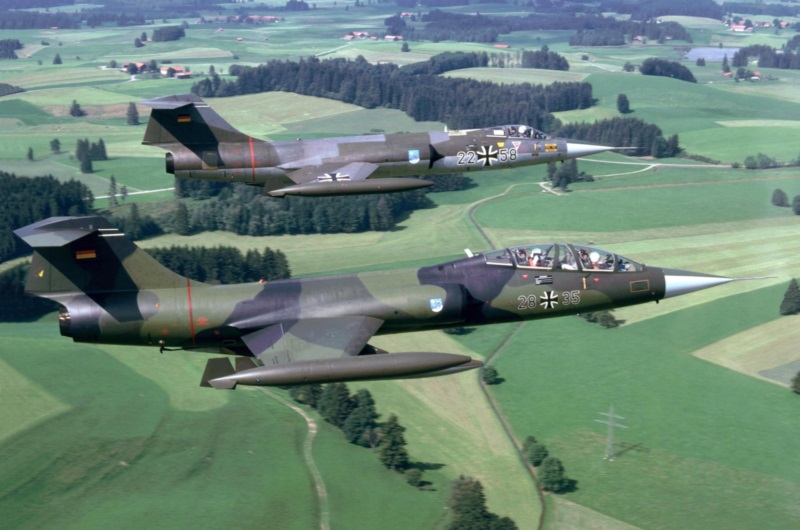
Much of the problem was the relative lack of experience of Luftwaffe maintenance and flight crews. One of the issues was that flight familiarization with the Starfighter was performed with Luftwaffe machines at Luke Air Force Base in the sunny state of Arizona, which gave the pilots plenty of open space to fly around in, but did not prepare them well for much murkier German weather. Underlying the problem was the fact that the arrival of the German Starfighter force meant a major expansion of the Luftwaffe, and growing an organization can lead to a wide range of problems. It should be noted that the Luftwaffe's accident rate with the F-84 / RF-84 had been as bad or worse.
German Starfighters were finally retired in the mid-1980s, being replaced by the Panavia Tornado and the F-4 Phantom, lingering on in specialized roles into the early 1990s. Many of the survivors were passed on to other air arms. Total losses were 270 aircraft, or about 30% of the force. Other air forces had higher loss rates, but the Luftwaffe was by far the biggest operator of the Starfighter, and so had the highest absolute number of losses. After the F-104, the Germans would have a strong aversion to single-engine fighter aircraft.
* As a footnote to German service, in the early days Luftwaffe Starfighter operations there was a worry about the vulnerability of airfields to a first strike, and a number of concepts were explored to find ways of getting around the problem. One exercise involved trials using three F-104Gs fitted with catapult gear and arresting hooks so they could be launched by a catapult system from a short airfield. The program was designated "Short Airfield for Tactical Support (SATS)".
A more drastic approach was to use "zero length launch (ZELL)" with the F-104G, blasting the aircraft off a trailer or out of a hard shelter using a big solid-fuel booster rocket. The US had already developed the technology to launch F-100 Super Sabres and the gear was modified for the F-104G, with a series of ZELL tests in 1963. The test program went very well, with test pilots commenting on how straightforward and smooth the ZELL shots were. However, neither SATS nor ZELL were fielded.
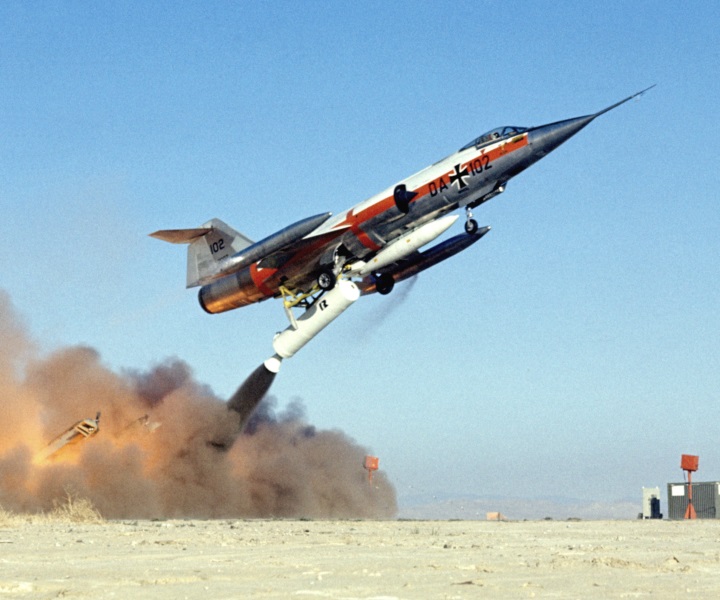
Similarly, Lockheed proposed a number of vertical take-off & landing (VTOL) variants of the Starfighter to get around the airfield bottleneck, with these machines featuring such gimmicks as small "liftjet" engines in the fuselage or swiveling jets on the wingtips. They never got beyond the paper stage, but during the 1960s the Germans did develop an experimental supersonic VTOL fighter with wingtip jets, the "VJ-101", that clearly had some Starfighter design influence, though it was a completely different aircraft.
Much later, in the 1970s, the German firm Messerschmitt-Boelkow-Blohm (MBB), a late-1960s consolidation of German aircraft manufacturers, modified an F-104G to perform experiments on the merits of "dynamically unstable" aircraft, meaning machines that would be impossible to control if they didn't have an electronic "fly-by-wire (FBW)" flight control system to keep an eye on what was going on at all times and adjusting flight trim accordingly. The modified Starfighter, known as the "F-104CCV" for "Control Configured Vehicle" performed its first flight in 1977.
The kit for the electronic FBW system was housed in bulges on each side of the top of the fuselage near the rear of the wing. The aircraft was gradually ballasted to shift its center of gravity and increase its instability, and then in 1980 was flown with a canard flight surface, actually a standard F-104 tailplane tacked on to the forward fuselage, to increase the instability of the aircraft. The test program ended in 1984, with the aircraft ending up in a museum.
* The Netherlands was another major European Starfighter user, with the type going into service to replace the F-84 / RF-84, as well as Lockheed RT-33s. The Dutch acquired 95 F-104Gs, 25 RF-104Gs, and 18 TF-104Gs from Fokker, Fiat, and Lockheed production. That gave a total of 120 single-seaters and 18 two-seaters, or 135 aircraft in all. Dutch RF-104Gs did not have the trimetrogon camera system, instead being fitted with the NVOI Orpheus centerline reconnaissance pod, with five TA-8M film cameras and an infrared linescan unit.
Dutch Starfighters were delivered in overall anti-corrosion gray colors, but were given the standard NATO camouflage of a dark gray / dark green disruptive pattern on top and medium gray underneath. These machines served into the mid-1980s, being ultimately replaced by the F-16. Some of the survivors were passed on to Greece and Turkey. The Dutch lost a total of 43 Starfighters from accidents, a painful attrition rate of 35.8%.
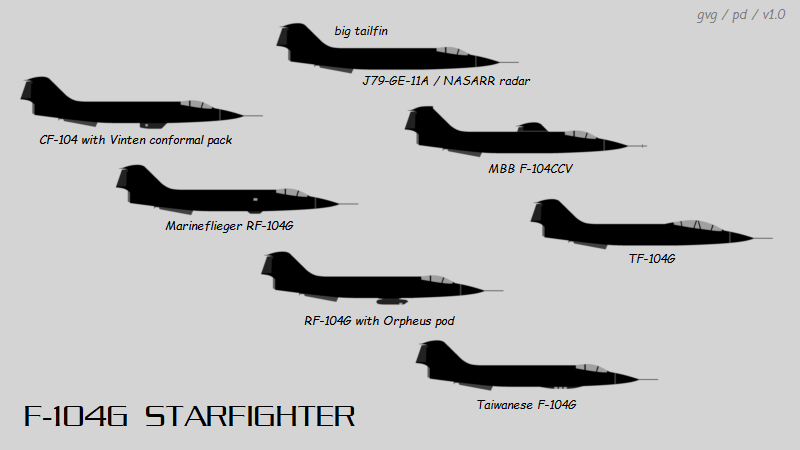
* Belgium obtained 101 F-104Gs from SABCA production and 12 TF-104Gs from Lockheed production, with deliveries from 1963 through 1965. It appears that one of the F-104Gs was Lockheed-built as a pattern aircraft, to be torn down and reassembled by SABCA.
Belgian Starfighters were originally flown in natural metal but were later painted in a camouflage scheme, with light gray on the bottom and a disruptive pattern of olive drab / dark green / tan on top. The last Belgian F-104s were phased out of service in 1983, being replaced by the F-16. The Belgians lost 41 of their Starfighters in accidents, an even more painful attrition rate of about 37%.
BACK_TO_TOP* A modified ex-USAF F-104A was supplied to Canadair as an initial pattern aircraft for CF-104 production. The type was originally designated the "CF-111" and had the company designation of "CL-90". Deliveries of the CF-104 began in 1961, with the first rolled out on 18 March 1961 and performing its first flight from Palmdale, California, ten days later. A total of 200 CF-104s was built for the RCAF, and except for an operational conversion unit at Cold Lake, Alberta, they were all used in Europe as part of Canada's NATO commitment.
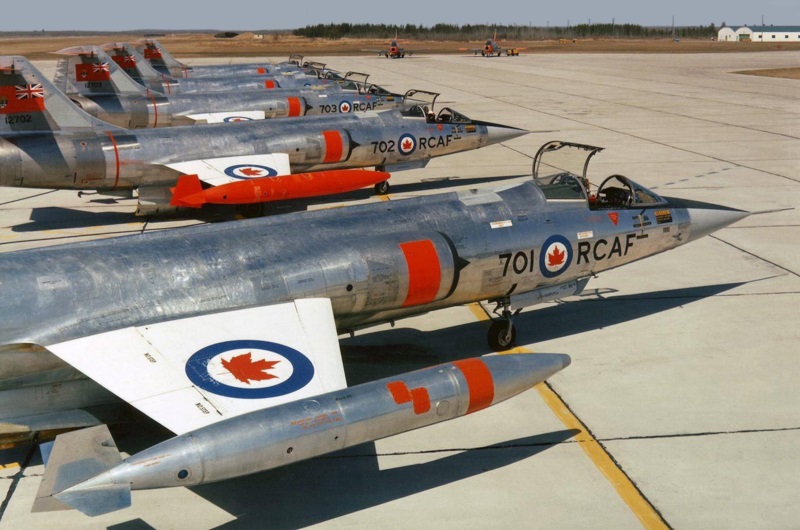
The CF-104 was almost identical to the F-104G. It was powered by the J79-OEL-7 turbojet, a J79-GE-7A built under license by Orenda of Canada. CF-104s were originally tasked with the nuclear strike role; the Vulcan cannon and gunsight were not fitted. These aircraft were converted to the tactical strike role in the early 1970s, to be refitted with the Vulcan cannon and gunsight. External ordnance for tactical strike included dumb bombs, CRV 70 unguided rocket pods, and the British Hunting Engineering BL755 cluster bomb.
Since CF-104Ds were intended as strike aircraft, they used the R24A version of the NASARR radar that deleted air-to-air capability. Some CF-104s were wired to carry a Vinten conformal reconnaissance pack under the belly, but they were not given a different designation. The variation in Starfighter reconnaissance configurations is a confusing subject.
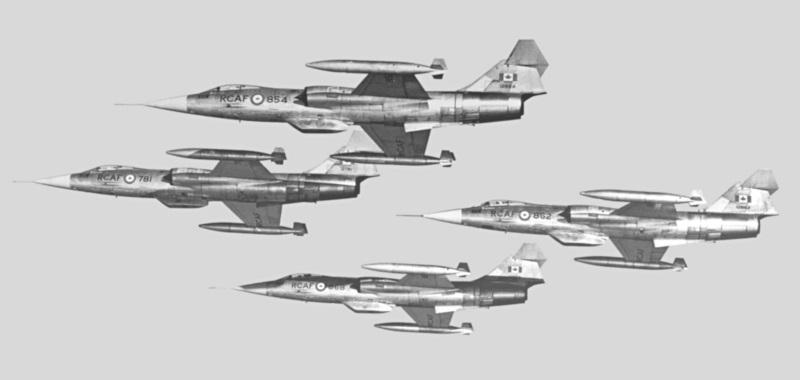
The RCAF obtained 38 "CF-104D" two-seaters that were similar to the TF-104G. These were all Lockheed-built machines and were originally designated "CF-111D", though some sources claim they were known as "CF-113s". The last 16 of the CF-104Ds featured a slightly upgraded standard of equipment and were given the designation of "CF-104 Mark 2". The Canadians also considered obtaining the "CL-41R", a version of the Canadair CL-41 Tutor jet trainer with NASARR radar and a Starfighter-style needle nose, to help train Starfighter aircrew, but though a prototype was flown, the RCAF decided not to buy it. After completion of RCAF production, the US Defense Department awarded a contract with Canadair to build 140 F-104Gs for supply to US allies under MAP.
Canadian Starfighters originally flew in natural metal colors. They were later repainted with a light gray bottom and a disruptive pattern of dark green and olive drab on top, and were finally painted overall dark green. Late in their service lives, Canadian CF-104s were fitted with an RWR system, with antennas located under the nose and under the jetpipe.
The RCAF phased out their Starfighters in the mid-1980s, with the type being replaced by the McDonnell Douglas F/A-18 Hornet. Despite the bad press of the F-104 in Luftwaffe service, it was the Canadians who had the worst attrition rate, with 110 destroyed in crashes, about 46% of the total -- though the RCAF also put substantially more hours on their Starfighters than did the Germans. After their retirement from RCAF service, many CF-104s and CF-104Ds were passed on to other air arms.
BACK_TO_TOP* Fiat manufactured a total of 125 F-104Gs for the Italian Air Force (Aeronautica Militaire Italiana / AMI). One of these machines was a pattern aircraft supplied by Lockheed. The first Fiat-built F-104G performed its initial flight on 9 June 1962, with the first operational Starfighter squadrons coming online in 1965. The Starfighter replaced the F-86 and F-84 / RF-84 in AMI service. The F-104 acquired a number of nicknames in Italian service, the most prominent being "Spillone (Hatpin)".
Of the 125 F-104Gs for the AMI, 51 were configured as interceptors, 54 were configured for the strike role, and 20 were configured as RF-104Gs, with the built-in trimetrogon camera arrangement. A number of F-104Gs would later be modified to carry the Dutch Orpheus reconnaissance pod.
The AMI also obtained 12 TF-104Gs from Lockheed and 12 from Aeritalia, giving a total of 24 trainers. Six more TF-104Gs were passed on from Luftwaffe stocks in the mid-1980s, with at least two refurbished and some used as spares hulks. The Italians also considered obtaining a version of the Macchi MB-326 trainer with NASARR radar and a Starfighter nose, but this project never got out of the paper stage.
Italian F-104Gs were delivered with the Martin Baker 1Q7A ejection seat. The Italians were generally consistent in their color schemes, providing their Starfighters with a dark gray / dark green disruptive pattern on top and light gray on the bottom. They seemed particularly fond of flashy temporary paint jobs for special occasions, for example with a stretched-out cat chasing mice on one side of the fuselage.
* The Italians liked the Starfighter enough to order an enhanced variant, the "CL-901" or "F-104S", the "S" indicating carriage of the Sparrow semi-active radar homing medium-range AAM. The AMI considered other aircraft for the service requirement, including the Dassault Mirage III, the F-4 Phantom, and the F-5, but despite the Starfighter's accident record the F-104 won out, the award being announced in 1965. The Phantom was more flexible, but the F-104S was faster, cheaper and, very importantly, provided more work for the Italian aviation industry.
Two subvariants were built, the "F-104S/CI" for the interceptor role and the "F-104S/CB" for the fighter-bomber role. They featured:
Primary armament of the interceptor subvariant was two AIM-7 Sparrow III AAMs, plus two or more Sidewinders. The cannon was deleted to make space for Sparrow control systems. When late-model Sparrows and Sidewinders were introduced that were far more reliable and effective than those used in the 1960s, the F-104S was a formidable interceptor. The attack subvariant retained the Vulcan cannon, and could carry a total external warload of 3,400 kilograms (7,500 pounds). Images show it carrying six 340-kilogram (750-pound) bombs; other bombload configurations were apparently possible.
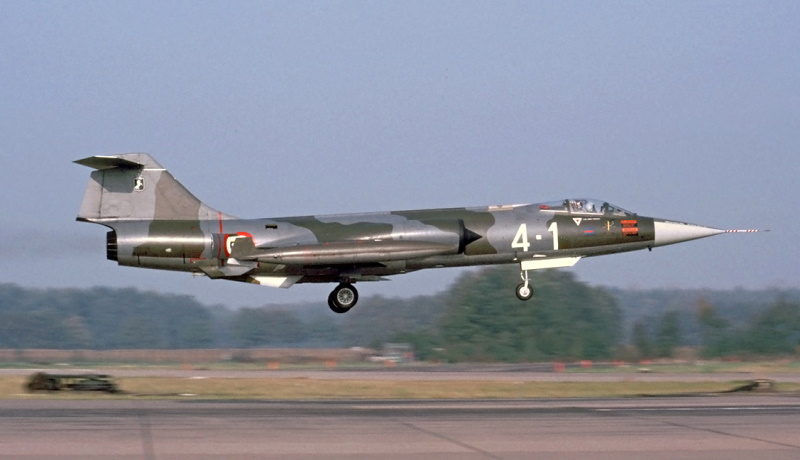
Lockheed modified two Italian F-104Gs into prototypes for the F-104S. The first prototype flew on 22 December 1966, followed by the second in March 1967. Fiat built 206 F-104S Super Starfighters for the AMI, the total being split roughly evenly between interceptors and fighter-bombers, as well as 81 for the Turkish Air Force. Initial deliveries to the AMI were in 1969, and the last F-104S was delivered in 1979. Another 40 F-104S Starfighters were built for the Turks, giving a total production of 246 machines.
Final deliveries of the F-104S led to the AMI's withdrawal of the F-104G from the interceptor and fighter-bomber roles in the early 1980s, though as mentioned some F-104Gs were modified to carry the Orpheus pod for the reconnaissance mission. These reconnaissance machines actually served in the Gulf War in 1991, flying out of Turkish bases to keep an eye on northern Iraq.
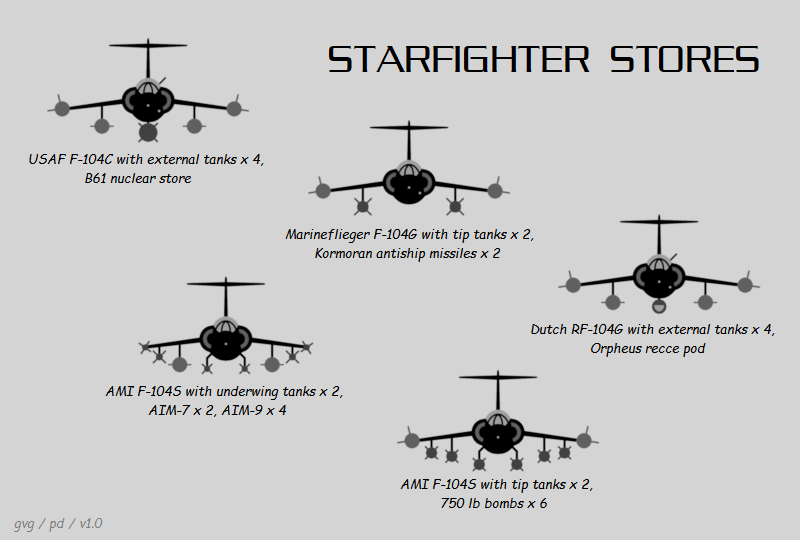
* In the early 1980s an upgrade program, the "Aggiornamento Systema d'Arma / ASA / Updated Weapons System", was implemented for 147 AMI F-104S Starfighters, though the initial plan had been for 153 aircraft. The first upgraded aircraft was flown in 1984, with service deliveries from 1986 into 1993.
The F-104S ASA featured improved FIAR radar with look-down shoot-down capability; a capable self-defense suite with an RWR and chaff-flare dispensers; and carriage of the Selenia Aspide 1A AAM, a derivative of the AIM-7E Sparrow. The Vulcan cannon was refitted to upgraded interceptors, since the avionics had shrunk considerably in the meantime. In principle the F-104S ASA could carry the Kormoran anti-ship missile, though in practice it never did.
The F-104S ASA was selected basically as an interim solution until the multi-national Eurofighter was available, but as is often the case in multi-national programs, the Eurofighter development effort dragged out. In the late 1990s, faced with the obsolescence of the Starfighter force, the AMI decided to lease 24 ex-Royal Air Force Tornado interceptors, and upgrade a subset of the Starfighter force again.
The modernization program was relatively minimal, focusing mostly on simply keeping the machines flying safely while doing little to improve combat effectiveness. The electrical system was replaced and a new avionics suite was installed -- featuring a new INS, a (separate) Global Positioning System (GPS) receiver, and other new kit. 49 F-104S ASA machines were upgraded, being given the designation of "F-104S ASA-M", and 15 TF-104Gs were upgraded, being given the designation of "TF-104G-M". The gunsight and countermeasures suite of the single-seaters were pulled, while all combat gear was yanked from the two-seaters.
Initial flight of the F-104S ASA-M was in 1995, with initial deliveries in 1997. These machines served in an operational role in 1999 during Operation ALLIED FORCE, the NATO air campaign against Serbia. The Starfighters were used for combat air patrols, being occasionally directed by airborne warning and control aircraft to check out bogeys.
The last AMI Starfighter was retired in the summer of 2004. At least 138 were lost in crashes, or about 37.5% of the total.
BACK_TO_TOP* The Japanese Air Self-Defense Force (JASDF) obtained a total of 210 "F-104J" single-seaters and 20 "F-104DJ" two-seaters. Three of the F-104Js were provided by Lockheed as pattern machines for a production group led by Mitsubishi Heavy Industries (MHI); 29 were assembled by MHI from knockdown kits; and the rest of the single-seaters were built by MHI with mostly local content. The first F-104J made its initial flight on 30 June 1961, with MHI assembly and production beginning in the spring of 1962 and running into 1967. The F-104DJs were all provided as knockdown kits and were assembled by MHI in parallel with F-104J production.
The F-104J / F-104DJ were based on the F-104G / TF-104G airframe but, in keeping with the strict Japanese "self-defense" mentality, were optimized for the interceptor role, with a different set of avionics, including some Japanese kit. They used the F15J-31 variant of the NASARR radar, which featured only air-to-air modes. Primary armament was the Sidewinder AAM. They were powered by the J79-IHI-11A engine, which was a J79-GE-11A built under license by Ishikawajima-Harima Heavy Industries (IHI). Photos show some F-104Js with the centerline catamaran mount for twin Sidewinders.
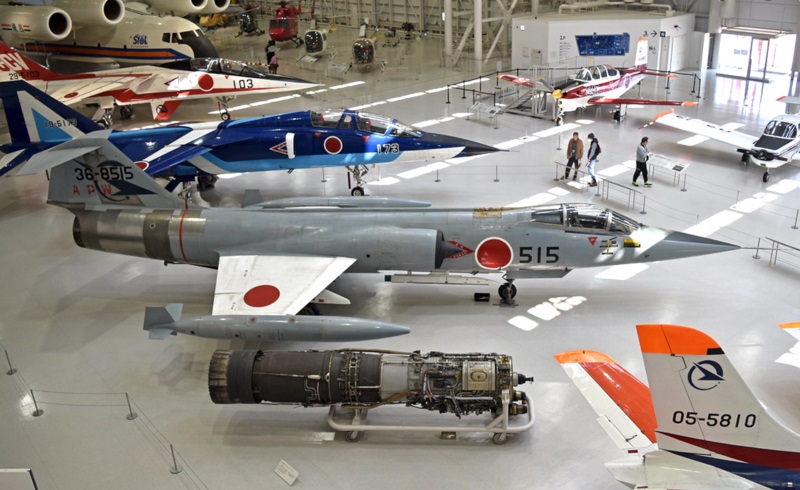
Japanese Starfighters were originally flown in natural-metal finish, with white-painted wings highlighting the red "Rising Sun" national insignia to help recognition. Later they were painted overall light gray to prevent corrosion, with some aircraft given a black nose. Apparently JASDF aircrew really liked the F-104J; it was a real pilot's aircraft, a fitting mount for a sky samurai.
The JASDF finally retired their F-104s in the mid-1980s, to be replaced by the McDonnell F-15J Eagle. Some were retained in special roles for a time, and others were passed on to Taiwan. The JASDF lost about 15% of their Starfighters in accidents, not too bad an attrition rate for two decades of operations. A few F-104Js were converted to "QF-104J" target drones in the 1990s.
BACK_TO_TOP